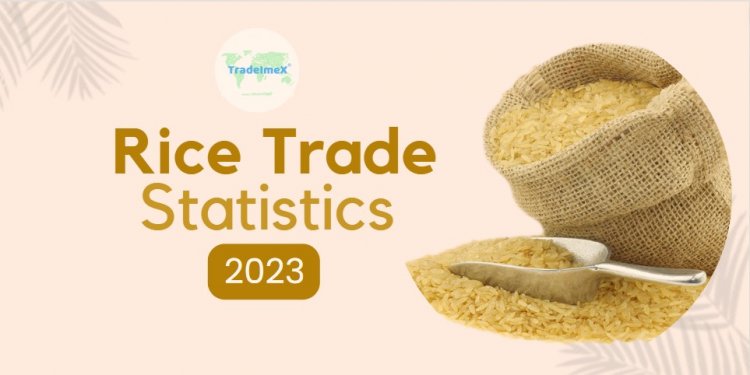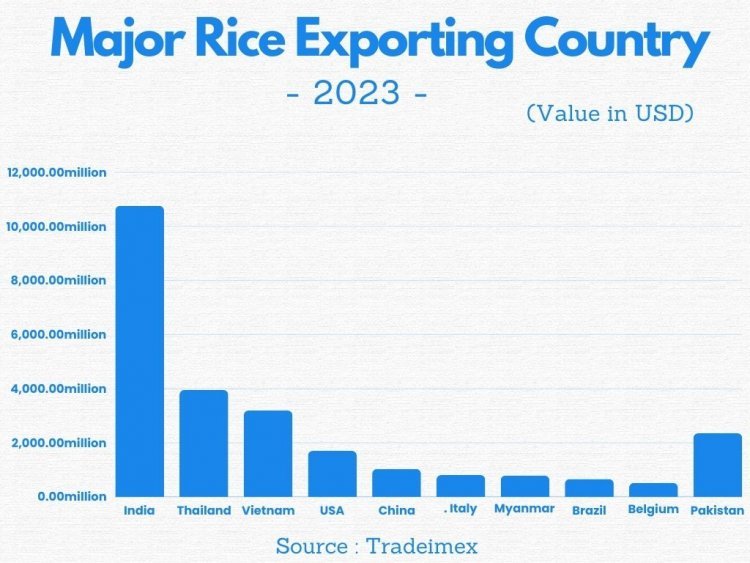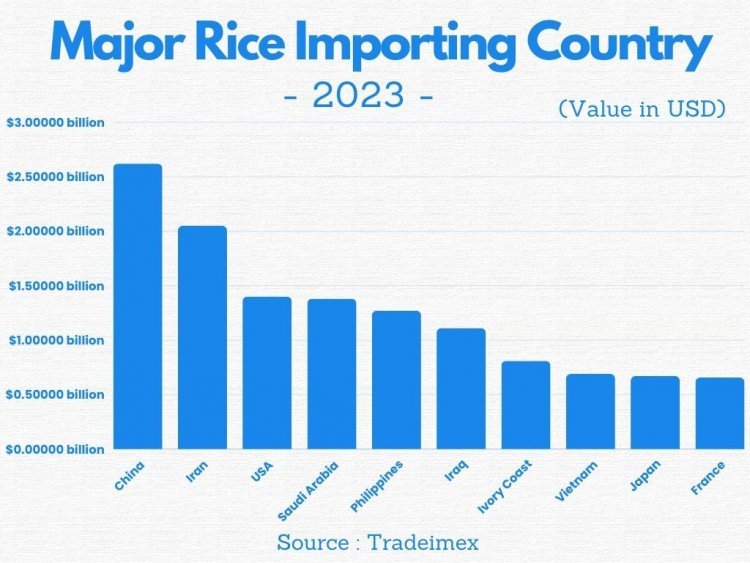Rice Import-Export Trade Statistics of 2023
Discover the latest trends and projections for Rice trade statistics in 2023. get the global trade data statistics of rice, Acquire valuable information on the rice import/export figures of 2023.

Rice Trade Statistics of 2023
Rice is one of the most important chief crops across the globe, with a significant impact on husbandry and food security. The transnational rice trade allows countries to meet their domestic demand, ground force gaps, and benefit from relative advantages in product. In 2023, the global rice trade is anticipated to witness significant growth, with several countries playing a crucial part in the import request. In recent times, the global rice trade has been expanding steadily, driven by colorful factors similar to population growth, changing salutary preferences, and adding urbanization. The trade volume is projected to continue its upward line in 2023, with multitudinous countries contributing to rice exports. This article explores the projected rice trade statistics for 2023 and highlights the biggest rice-exporter countries.
Get an Overview of the Global Rice Trade Market
With an increasing demand for rice worldwide, countries like China, India, Thailand, Vietnam, and the United States are anticipated to dominate the request as the biggest rice exporter countries. Also, half of the world's population relies primarily on rice, with South America, Asia, and Sub-Saharan Africa being the three regions with the loftiest consumption rates. Oryza sativa, a factory species belonging to the Graminicide(lawn) family, is said to have begun in Asia and accounts for the maturity of the world's rice product. The physical conditions demanded to cultivate rice are exclusive to specific regions of the world, though rice is produced there.
Who is the major Rice Exporting Country in 2023?
Over 700 million metric tons of mulled rice have been produced annually in the world throughout the once many times. The global affair of mulled rice was anticipated to reach around 510 million metric tons by 2022. India's 25 rice had the smallest average import price per ton in 2021, and California's medium-grain rice from the United States had the loftiest import price among the different kinds of rice. As of 2023, India was the world's largest rice exporter, with 21.5 million metric tons. Thailand ranked as the alternate-largest rice exporter in the world, with 8.2 million metric tons of rice exported encyclopedically at that time. The top 10 rice exporting nations have made a name for themselves as important suppliers and control a sizeable portion of the world rice request. India is the biggest rice exporter in the world with 21.5 metric tons and$10.76 billion in rice exports in 2023. The biggest rice exporters in 2023 farther include:

1. India ($10.76 billion) 35.8%
India is famed for its high-quality basmati rice, which enjoys immense popularity in both domestic and transnational requests. As the largest rice exporter encyclopedically, India is well- deposited to subsidize the growing demand for rice. In 2023, Indian rice exports increased further, driven by favorable trade programs and advancements in product technology. India has been the world's biggest exporter of rice since 2012; its monthly exports of rice now exceed the combined shipments of the three largest exporters. India's rice exports grew by about 49% in 2021, 46% further in 2022 to exceed 21 million tons, and 21.5 million tons in 2023, when they peaked.
2. Thailand ($3.95 billion) 13.2%
3. Vietnam ($3.19 billion) 10.6%
4. Pakistan ($2.35 billion) 7.8%
5. USA ($1.70 billion) 5.7%
6. China ($1.03 billion) 3.4%
7. Italy ($804.68 million) 2.7%
8. Myanmar ($786.83 million) 2.6%
9. Brazil ($657.48 million) 2.2%
10. Belgium ($515.57 million) 1.7%
Who is the biggest producer of rice in the world?
China is the world's largest producer of rice, with a periodic crop of around 148.9 million metric tons in 2023. roughly 515 million tons of rice was precipitously produced encyclopedically by the end of 2023. This indicates a rise in worldwide products of 0.23%. The Sub-Saharan African region imports the majority of rice, while China and India continue to be the world's largest directors of rice. Roughly 80% of the global rice force is gathered in 10 nations. Rice will remain a major source of calories and aliment as the world's population grows.
- China (149 million metric tons): China bought 5 million tons of rice in 2023 in addition to producing 149 metric tons of rice domestically. In 2023, China will export 2.2 million tons of rice.
- India (124 million metric tons): With 109 million tons of rice imported and a record-breaking 19.5 million tons exported in 2023, India produced 124 million tons of rice.
- Indonesia (34.6 million metric tons): With 34.6 million tons produced, Indonesia is now the third-largest producer of rice in the world.
- Vietnam (27.4 million metric tons): Vietnam is projected to produce 27.23 million tons of rice in 2023. It is anticipated that the country in Southeast Asia will use 21.5 million tons domestically and export 7.2 million tons.
- Thailand (20.1 million metric tons): In 2023, Thailand produced 20.10 million tons of rice, of which 8.2 million tons were exported.
- Myanmar (12.5 million metric tons): With a population of about 55 million, Myanmar produced 12.5 million tons of rice in 2023, of which 10.3 million were consumed locally and 2.4 million were sold.
- Philippines (12.41 million metric tons): The Philippines ranked sixth in the world for rice production in 2023 with 12.41 million tons produced.
- Japan (7.45 million metric tons): Japan is a significant rice producer, but it doesn't export much of its crop since it needs to feed its almost 126 million citizens. In 2023, Japan was the producer of 7.45 million tons of rice.
- Brazil (7.3 million metric tons): With 7.3 million tons of rice produced from the 2023 crop, Brazil is a significant rice producer.
- Pakistan (6.6 million metric tons): Pakistan, which used 3.7 million tons and exported 4 million tons of rice in 2023, rounded out the top 10 rice producers with 6.6 million tons of rice produced in 2023.
Who is the major rice importing country in 2023?
Regarding rice imports worldwide, Sub-Saharan Africa continues to be the biggest region, with slightly further imports than all of Asia combined and about 30% of overall significance and imports. Over 70 percent of rice consumed in the Middle East comes from this significant worldwide import sector. A significant import request, Southeast Asia has lately endured development following times of recession as the region's affairs increased. With about 4 million tons imported annually, the Philippines is the biggest importer of rice in both Southeast Asia and the world. China's significant imports of rice in 2023 increased East Asia's imports, although these significances have since stabilized.
Rice, being a staple food for more than half of the world's population, plays a pivotal part in transnational trade. The global rice request is largely different, with different countries having varying situations of demand and force. China is the biggest importer of rice in the world with a total value of $2.62 billion in rice imports in 2023. The major rice importers in the world in 2023 include:

1. China ($2.62 billion) 7.9%
With around 4.6 million metric tons of rice imports in the 2023 trade year, China ranked first globally in terms of rice imports. China imported rice with a total value of $2.62 billion in 2023. Although the growing season in the south begins earlier, rice is farmed across the nation. China is not only one of the top consumers of rice worldwide but also one of the biggest producers of the grain. In China, rice is grown primarily by hand.
2. Iran ($2.05 billion) 6.2%
3. USA ($1.40 billion) 4.3%
4. Saudi Arabia ($1.38 billion) 4.2%
5. Philippines ($1.27 billion) 3.9%
6. Iraq ($1.11 billion) 3.4%
7. Ivory Coast ($809.96 million) 2.5%
8. Vietnam ($689.62 million) 2.1%
9. Japan ($670.35 million) 2%
10. France ($655.93 million) 2%
What is the HS Code for Rice?
The Hs code for rice is 1006 encyclopedically. Rice, being an extensively traded commodity, has a specific HS law to classify its colorful types and forms. The HS law for rice falls under Chapter 10 of the HS law bracket, which covers cereals. The particular HS law for rice varies based on factors like raw or reused state, form, and grain length. There are some HS code groups for different kinds of rice
- HS Code for Unhusked Rice: 1006.10
- HS Code for Husked Rice: 1006.20
- HS Code for Parboiled Rice: 1006.30
- HS Code for Semi-Milled Rice: 1006.40
- HS Code for Basmati rice: 10063020
What are the top rice exporting companies in the world?
The top rice exporting companies in the world play a pivotal part in meeting the global demand for this staple grain. Their focus on quality, sustainability, and client satisfaction has enabled them to capture significant request shares in the largely competitive rice import assiduity. The top 10 rice exporting companies in the world include:
1. A & D Agro & Foods: India
2. A. A. Saroja Overseas Exports: India
3. A. Costa e Silva, Lda: Portugal
4. Alishan Trading Company LLC: The United Arab Emirates
5. Aarvi General Trading LLC: The United Arab Emirates
6. Aayu Exports: India
7. Abram General Trading LLC: The United Arab Emirates
8. Acinus Exports Private Limited: India
9. Acme Exports: India
10. Adani Wilmar Limited: India
Types of rice and their demand in the global market
Rice is one of the most extensively consumed staple foods around the world. It's a protean grain that forms the primary salutary chief for further than half of the global population. With its multitudinous kinds, rice has gained immense popularity due to its different nutritive biographies and culinary uses. Here are some major kinds of Rice in the world with their export value in 2023:
1. Long-grain or Basmati Rice ($4.94 billion)
Long-grain or Basmati rice is characterized by its long and slender grains. This type of rice has a high bounce content, performing in ethereal and separate grains when cooked. It's generally set up in dishes like biryani, pilaf, and stir-feasts. Basmati rice, a popular long-grain variety hailing from India and Pakistan, is largely sought after for its unique aroma and delicately nutty flavor. Its demand in the global request remains substantial, particularly in Middle Eastern, Indian, and Pakistani cookeries.
2. Parboiled Rice ($2.76 billion)
Parboiled rice undergoes a unique processing system wherein the paddy is incompletely boiled before removing the external cocoon. This process helps in retaining a significant quantum of nutrients within the grain. coddled rice grains are slightly unheroic and have a firmer texture than regular white rice. This type of rice is extensively consumed in numerous corridors of Asia, Africa, and the Americas. Its demand in the global request has been increasing due to the growing mindfulness of its nutritive benefits.
3. Medium-grain rice ($2.12 billion)
Medium-grain rice has a slightly shorter and corpulent grain compared to long-grain rice. It has an advanced humidity content and a tendency to stick together when cooked, making it ideal for dishes like sushi, risotto, and paella. Arborio rice, formed in Italy, is a well-known medium-grain variety that's largely valued for its capability to absorb flavors and produce a delicate texture. The demand for medium-grain rice has witnessed steady growth in colorful global requests owing to the added popularity of ethnic cookeries.
4. Short-grain Rice ($1.21 billion)
Short-grain rice, as the name suggests, has short and stocky grains. It's characterized by its advanced bounce content, which gives it a stickier texture when cooked. This type of rice is generally used in sushi, rice puddings, and rice galettes. Japanese kinds similar to Koshihikari and Sasanishiki are largely prized for their superior taste and texture. The demand for short-grain rice has been primarily fueled by the growing popularity of Japanese cookery worldwide.
5. Organic and Specialty Rice ($1.09 billion)
With the rising demand for organic and specialty foods, the global request for organic and specialty rice has endured substantial growth. Organic rice is grown without the use of synthetic diseases, fungicides, or genetically modified organisms. Specialty rice, on the other hand, encompasses unique kinds like black rice, red rice, and wild rice, which offer distinct flavors and textures. The demand for organic and specialty rice is fueled by health-conscious consumers who prioritize sustainability and unique culinary food.
6. Husked Rice or Brown rice ($12.31 million)
Brown rice or husked rice is the whole-grain interpretation of rice, with only the housing removed. Its demand in the global request has been growing steadily due to its nutritive value, as it retains the bran and origin, furnishing further fiber, vitamins, and minerals compared to white rice.
Reasons Why did India stop exporting rice in 2023?
India, known as the world's largest exporter of rice, made a surprising decision in 2023 to halt its rice exports. This move raised several questions and enterprises both domestically and internationally. Some reasons why India stopped its rice exports in 2023 are mentioned below:
- Declining Domestic Stocks
One of the primary reasons for India's halt in rice exports in 2023 was the declining domestic stocks. Over time, India has been exporting large amounts of rice to meet the demands of other countries. Still, due to unlooked-for circumstances similar to inimical rainfall conditions, low crop yields, and rising domestic consumption, the country's rice reserves were depleting fleetly.
- Added Domestic Demand
India, with a population of over 1.3 billion people, has been witnessing a steady rise in domestic demand for rice. The ever-adding population coupled with salutary preferences that heavily calculate on rice as a staple food significantly contributed to the swell in demand. As a result, the Indian government made the delicate decision to prioritize meeting the requirements of its citizens rather than feeding the global request.
- Government enterprise
To address the rising demand for rice within the country, the Indian government enforced several enterprises concentrated on perfecting food security and creating an acceptable force for its citizens. These enterprises included strategic plans to boost rice products, invest in agrarian structures, and give subventions to growers. By turning coffers and attempts towards meeting domestic conditions, the Indian government aimed to palliate enterprises about food and maintain stability within the country.
- Climate Change Impact
Climate change has been a significant factor affecting agrarian productivity worldwide, and India is no exception. changeable rainfall patterns, similar to famines, cataracts, and extreme temperatures, have taken a risk on rice civilization in various corridors of the country. These adverse conditions have led to reduced yields and, eventually, the need to conserve rice stocks for domestic consumption rather than exports.
- Global Counteraccusations
India's halt in rice exports in 2023 has global counteraccusations from both importers and exporters. Countries that heavily calculate on Indian rice may need to seek indispensable sources, potentially leading to increased demand and advanced prices in the transnational request. Again, other rice-exporting countries may witness an increase in demand for their products, presenting an occasion for them to fill the void left by India's absence.
Conclusion
To conclude, assaying rice trade statistics for 2023 provides precious perceptivity into the global rice market and request. Prognosticated numbers for rice products, trade volume, and the major exporting and importing countries give stakeholders regard to the future of this essential commodity. By understanding the factors that impact rice trade, countries and businesses can acclimatize their strategies to subsidize openings and navigate implicit challenges. The projected statistics for 2023 set the stage for a dynamic and ever-evolving rice trade geography.
Read more :-
Brazil Coffee Exports Statistics 2022-23
What's Your Reaction?
















